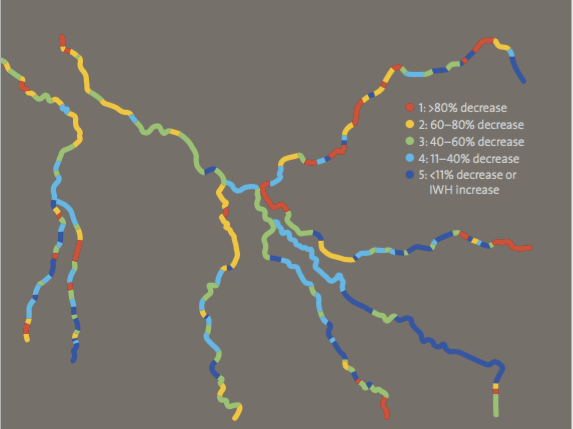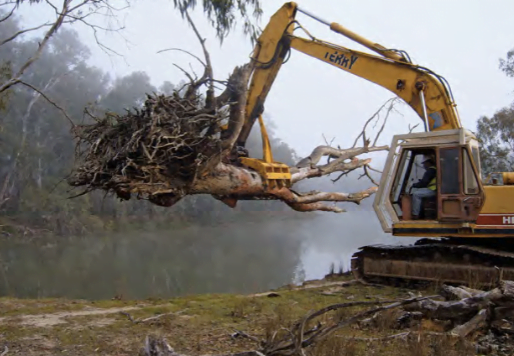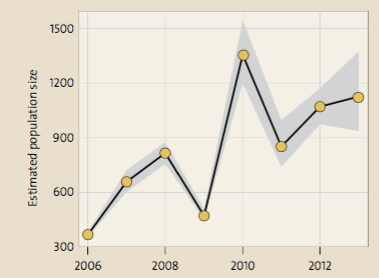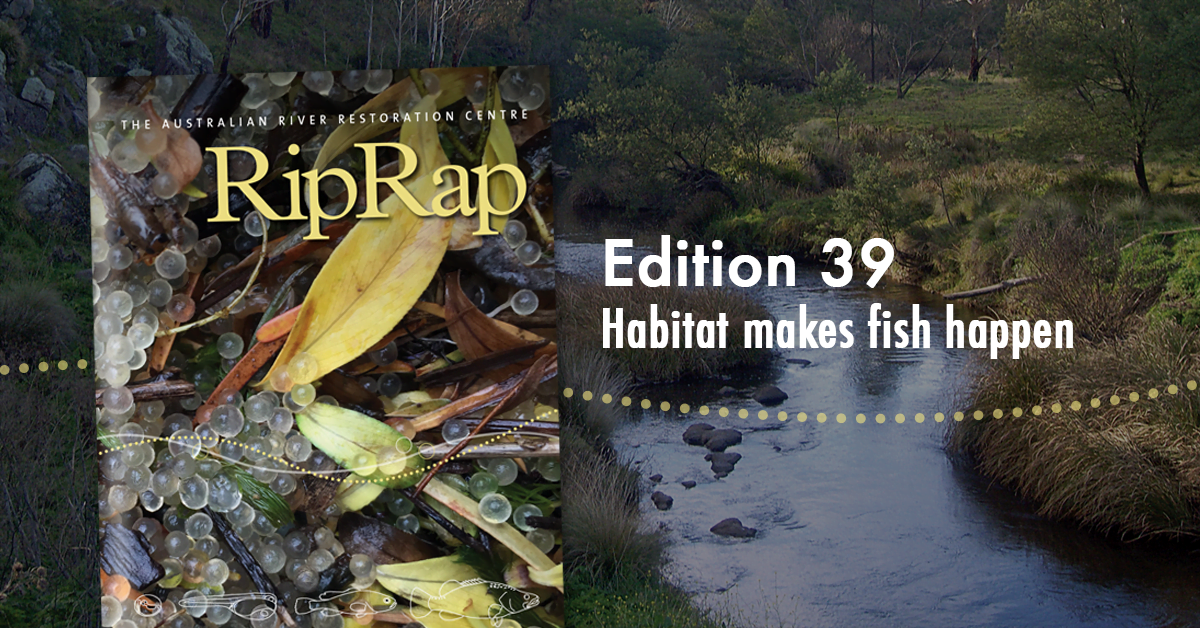Instream woody habitat (IWH or snags) are highly valued because of their contribution to catchment health, biodiversity and supporting self-sustaining fish populations, as well as providing a range of structural, chemical and ecological functions essential in maintaining riverine ecosystems. A vast amount of research has demonstrated positive associations between IWH and riverine fish populations, including:
- primary production processes of carbon input and nutrient cycling,
- local and reach scale hydraulics creating river features such as pools and riffles,
- fish habitat, homes, refuges and food,
- cover from predators, including birds, bigger fish and,
- spawning habitat, for example, the Murray cod lays eggs on or in large hollow logs.
There are often misguided community perceptions about the negative consequences of IWH on flooding, navigation an erosion, and this has led to extensive riparian clearing and the removal of large quantities of IWH from rivers across Australia. A recent investigation of IWH distribution and condition (as compared to estimates of pre-European loads) was conducted for approximately 28,000 kilometres of streams across Victoria. This work showed that Victorian streams currently have IWH volumes, on average, 41 per cent lower than pre-European loads, with 30 per cent of river reaches estimated to have more than 80 per cent reductions (See Figure 1).

These reductions have dramatically altered how Victoria’s rivers function, and channel enlargement, and loss of critical habitat. Such changes are major contributing factors to declines in riverine health and the subsequent decline of native fish populations.
Instream habitat restoration success across regional and local scales
Fortunately, there is increasing interest and investment in river restoration programs to help improve mainstream habitat and fish populations. Many of these programs involve the re-introduction of IWH, with accompanying riparian zone revegetation to encourage long-term natural IWH input. Monitoring programs assessing these in stream rehabilitation efforts are starting to demonstrate the benefits of these management actions to local fish populations.
Case Study 1: The Murray River Resnagging Experiment
Perhaps the largest IWH restoration (and subsequent monitoring) program o fits kind in Australia is the ‘Murray River Reengaging’ Project. The Murray-Darling Basin Authority’s ‘The Living Murray’ program has made efforts to alleviate historical degradation of IWH by ‘resnagging’ a 194 kilometre reach of the Murray River between Lake Hume and Lake Mulwala, with 4450 woody habitats installed along the river reach (less than 1 tonne each).

A seven-year research and monitoring project (2007-13) was undertaken by the Arthur Rylah Institute to quantify the benefits of the restoration efforts by investigating the population responses of four iconic large-bodied native species, Murray cod, Trout cod, Golden perch and Silver perch. The program’s monitoring strategy estimated the annual changes in the population size of each of these four native species within the restored reach, and compared these results to two reference reaches where no restoration was undertaken.
Target species fish were caught, with those tagged at the start of the program captured and assessed through annual boat electrofishing surveys. This data was complemented with measures to determine the age structure and biomass of the fish populations; fish movements from about 1400 radio-tagged fish’ and fish survival rates.
Annual changes in population size for each of the species in the target river reaches were then assessed by combining the different types of data collected. This technique enable researchers to:
- account for migration into, and out of the different study reaches,
- investigate differences in capture rates (which is how difficult it was to capture each fish species in each year), and
- investigate the temporary movements between study reaches and estimate fish survival.

Results of the monitoring suited showed a three-fold increase in the Murray cod population size following the large-scale IWH works (see Figure 2). This increase was due to both greater survival of juvenile fish, as well as immigration from outside the reach. This activity did not occur in the reference reaches.
Another part of the project was a research angler program which started in July 2007. This program encouraged local fishers to become involved by collecting information such as catch rates, as well as taking otoliths to age fish.
A total of 55 anglers were involved and collected data from 5465 fish. These results showed greater Murray cod numbers in the reengaged reach, which catch per ‘unit of effort’ increasing between 2007 and 2011.
Unfortunately, the same increase in population size was not detected for other species, including Trout cod. This is likely due to the limited connectivity with source populations which are found downstream of Lake Mulwala.
The study has shown that large-scale river restoration efforts enhance native fish populations which, in turn, provides ecological and recreational fishing benefits within the Murray River. Importantly, the study also increased community awareness by building knowledge around the importance of healthy habitat for native fish and river health.
Case Study 2: Enhancing Habitat Values in the upper Goulburn Catchment
While the Murray River reengaging project has demonstrated the benefits of large-scale river rehabilitation, smaller localised programs can also deliver benefits to fish populations. Between 2000 and 2008, the Goulburn Broken Catchment Management Authority conducted habitat enhancement works at several sites in the Goulburn, Delatite, Rubicon and Acheron Rivers, aimed primarily to benefit local trout populations. These on-ground works were funded largely by Victorian recreational fishing licence fees and involved:
- installing lunkers (artificial habitats constructed of wood and rock to replicate undercut banks),
- constructing deflecting rock groynes,
- boulder seeding (large boulders placed in the river), and
- stabilising banks and reinstating IWH.
Surveys conducted by Fisheries Victoria confirmed that fish were using these new habitats shortly after construction.

With up to 10 years having passed since the in stream habitat enhancement, questions were being asked as to whether these works continue to provide benefits for fish?
In 2015, the Arthur Rylah Institute followed up with surveys of habitat condition and fish occupancy at each of the habitat enhancement sites, as well as at several control sites (sites where no habitat enhancement was undertaken) for comparison. Results indicated significantly greater abundance and biomass of fish at habitat enhancement sites compared to control sites. At a species level, researchers reported such benefits were not only evident for the target species, Brown trout, but also native Two-spined blackfish!

Two-spined blackfish were a dominant species using instream habitat enhancement sites in the Delatite and Rubicon Rivers.
Where to from here?
Studies such as these provide waterway mangers with solid foundation upon which to undertake further IWH reintroductions. They demonstrate that instream habitat restoration can enhance fish populations, as well as having multiple ecological and recreational fishing benefits.
There is, however, still much to learn about how best to undertake such interventions. Unfortunately, rehabilitating IWH at the landscape scales over which it has been degraded is rarely feasible. Woody structure for use as IWH is often scarce and, along with the high cost of installation, restricts the extent of restoration efforts.
Any investment in restoration activities must, therefore, be carefully planned to preserve as many river ecosystem processes as possible, to link strategic ecosystems and, ultimately, result in catchment-scale reversal of declines in diversity and abundance of aquatic organisms. This approach works best when based on knowledge about fish species and IWH requirements, so that specific ecological objectives can be focused upon for a given river reach.
A Victorian statewide instream habitat research project is currently underway to help address such needs. Specifically, the project team are investigating the relationship between IWH attributes (an other environmental variables) and fish populations across Victoria. This will ultimately allow quantitative estimates of the IWH levels required to maximise the benefits for particular fish species in a specific river reach.
Community engagement
Instream habitat rehabilitation also offers opportunities to engage different community groups toward a common goal of restoring fish habitat. Community ownership an partnerships are critical, and successful restoration programs are those that have actively engaged multiple stakeholders in building knowledge and support around the importance of health habitat for fish and river health. We now see groups such as recreational fishers, Landcare, Waterwatch and Estuarywatch advocating for healthier fish habitats, and we are working with these organisations and government agencies to protect and rehabilitate our waterways.
Continuing to foster such linkages between community groups, waterway managers, policy and fisheries agencies is vital to gain the support needed for ongoing investment into waterway rehabilitation actives, community participation and long-term advocacy.
To read this and other great stories like it, you can purchase or download a copy of RipRap 39 magazine. A pdf version of Zeb and Jarod’s story is also available to download here.



